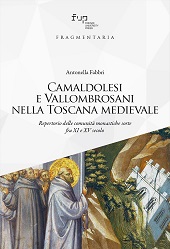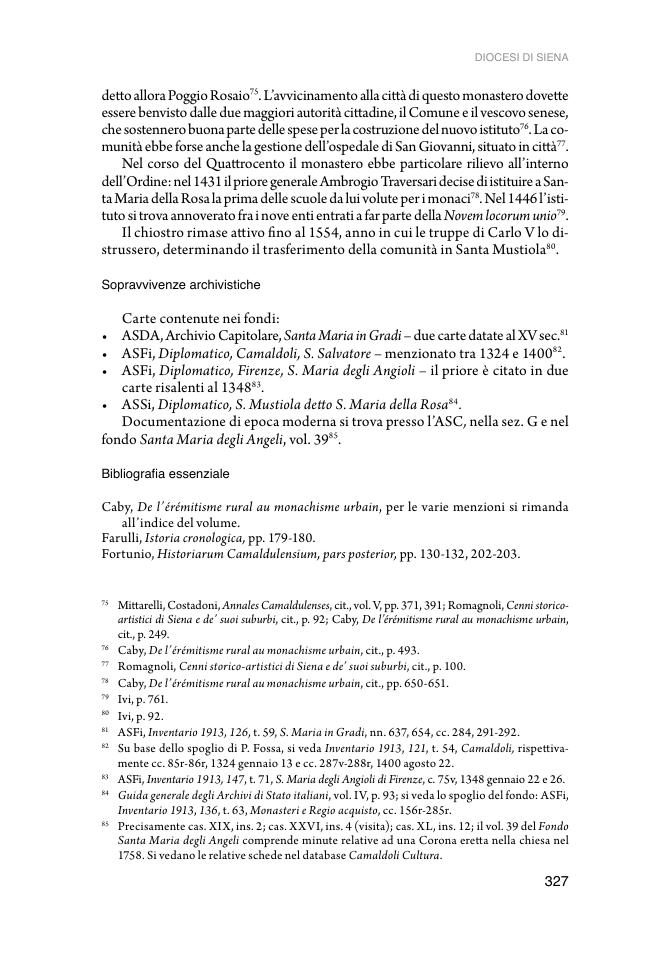Camaldolesi e vallombrosani nella Toscana medievale : repertorio delle comunità monastiche sorte fra XI e XV secolo
650 p. : ill.
Includes bibliographical references and index.
Nel contesto dell'intensa stagione di rinnovamento religioso e sociale avviatasi fra X e XI secolo con la cosiddetta 'Riforma Gregoriana', l'Eremo di Camaldoli e il monastero di Santa Maria di Vallombrosa, sorti entrambi nel territorio toscano, diedero origine a due movimenti di riforma ispirati alla spiritualità dei rispettivi fondatori, e divenuti due congregazioni appartenenti alla famiglia benedettina. Nati da istanze simili, gli Ordini camaldolese e vallombrosano furono per molti aspetti affini tra loro, sia in alcuni dei loro caratteri fondamentali, sia nei meccanismi che ne plasmarono le dinamiche di espansione.
Proprio partendo da questa considerazione, questo lavoro si propone di delineare un quadro della diffusione raggiunta in Toscana da queste riforme nel periodo medievale in un'ottica di confronto, attraverso la schedatura degli insediamenti noti e l'elaborazione di un repertorio delle comunità interessate da tale fenomeno, allo scopo di riunire un'ampia casistica di situazioni ed attori che influirono sulle modalità e i tempi di radicamento di queste riforme nelle varie zone della regione. Il testo è arricchito da un'appendice cartografica dedicata ad illustrare la cronologia dello sviluppo di queste congregazioni nella Toscana medievale.
Antonella Fabbri è laureata in Scienze Storiche presso l'Università di Firenze con una tesi in Storia medievale e sta attualmente frequentando il dottorato in Storia, territorio e patrimonio culturale dell'Università degli Studi Roma Tre. I suoi interessi di ricerca si sono orientati verso la storia delle riforme benedettine nel territorio toscano in epoca medievale, per poi rivolgersi allo studio dell'Ordine agostiniano nell'Italia medievale. [Testo dell'editore]
In the context of the intense religious and social renewal known as "Gregorian Reform", the Camaldoli Hermitage and the Vallombrosa Abbey, both located in the Tuscan territory, gave rise to two movements of reform inspired by the spirituality of the respective founders, which later became congregations belonging to the benedictine family. Motivated by common instances, the Camaldolese and the Vallombrosan Orders were similar in some of their essential features and in the dynamics of their expansion.
This statement has been the starting point of this work, which aims to formulate a comparative overview of the territorial spread of these reforms in Tuscany, by recording the known settlements and making an inventory of the religious communities interested by this phenomenom, in order to gather a broad range of examples of the way these movements interacted with the local situations in the different areas of the region. The text is enriched by a carthographic appendix illustrating the chronology of these congregations' development in medieval Tuscany.
Antonella Fabbri is graduated in Historical Sciences at the University of Florence with a dissertation in Medieval History, and she is now attending a PhD in History , Territory and Cultural Heritage at Roma Tre University. Her research interests have been directed in particular to the history of benedectine reforms in Tuscany during the Middle Ages and have recently included the study of the Augustinian Order in medieval Italy. [Publisher's text]
-
Informations



